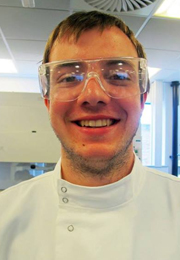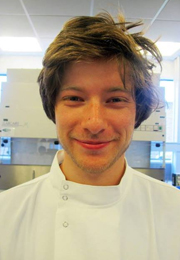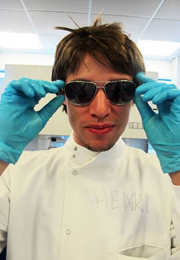Team:Exeter/Modelling
From 2013.igem.org
(Added hidden abstract section at top of page. This will be an abstract akin to a scientific paper we need results) |
(added hidden part in intro section) |
||
| Line 9: | Line 9: | ||
== Introduction == __NOTOC__ | == Introduction == __NOTOC__ | ||
| - | Our model predicts how the absorbtion spectrum of a modified E.Coli changes over time in response to a given incident light spectrum. It is used to estimate | + | Our model predicts how the absorbtion spectrum of a modified E.Coli changes over time in response to a given incident light spectrum. It is used to estimate key properties of our system such as stability, development time of image, the balance of colours and has three steps to its operation. |
| + | |||
| + | <!-- Firstly the rates of sensor activation for a given incident light spectrum is calculated using MATLAB. | ||
| + | |||
| + | Secondly the cell's response to the activation rates of the light sensors is simulated using KaSiM. | ||
| + | |||
| + | Thirdly the results of the KaSiM simulation are converted into an absorbtion spectrum over time using MATLAB --> | ||
Currently the model is based on results from literature and theoretical conjecture as experimental results are not available. The motivation for the model was to numerically characterize our bio-bricks for future use and to help us create the first colour coliroid. With experimental results the model could readily be updated to fulfill its original mandate. | Currently the model is based on results from literature and theoretical conjecture as experimental results are not available. The motivation for the model was to numerically characterize our bio-bricks for future use and to help us create the first colour coliroid. With experimental results the model could readily be updated to fulfill its original mandate. | ||
Revision as of 15:01, 2 October 2013
Introduction
Our model predicts how the absorbtion spectrum of a modified E.Coli changes over time in response to a given incident light spectrum. It is used to estimate key properties of our system such as stability, development time of image, the balance of colours and has three steps to its operation.
Currently the model is based on results from literature and theoretical conjecture as experimental results are not available. The motivation for the model was to numerically characterize our bio-bricks for future use and to help us create the first colour coliroid. With experimental results the model could readily be updated to fulfill its original mandate.
The Team
Physics |
Physics |
Electrical Engineering |
Modelling Software
The model uses two programs; [http://www.mathworks.co.uk/products/matlab/ MATLAB] and KaSiM combined using a batch file.
KaSiM is a [http://en.wikipedia.org/wiki/Stochastic stochastic] simulator that executes files written in [http://www.kappalanguage.org/ Kappa]. Kappa is a rule based modeling language for protein interaction networks.
MATLAB® is a high-level language and interactive environment for numerical computation, visualization, and programming. It can be used to analyze data, develop algorithms, and create models and applications.
Together they provide the necessary tools to create an accurate model of our bio-camera system.
The pathways
The model is composed of a red, green and a blue light activated pathway. The chemistry of each pathway is described by a set of rules. The rates of which are experimentally or theoretically determined.
Assumptions
Due to the complexity of biological systems our model will include but not be limited to the following assumptions:
- Classical elastic mechanics
- Bacteria contain a homogeneous mix of components
- All constituents move with brownian motion
- Bacteria are identical
- Bacteria evenly distributed across surface
- Bacteria do not interact
- Only pathway specific species are rate limiting
 "
"







